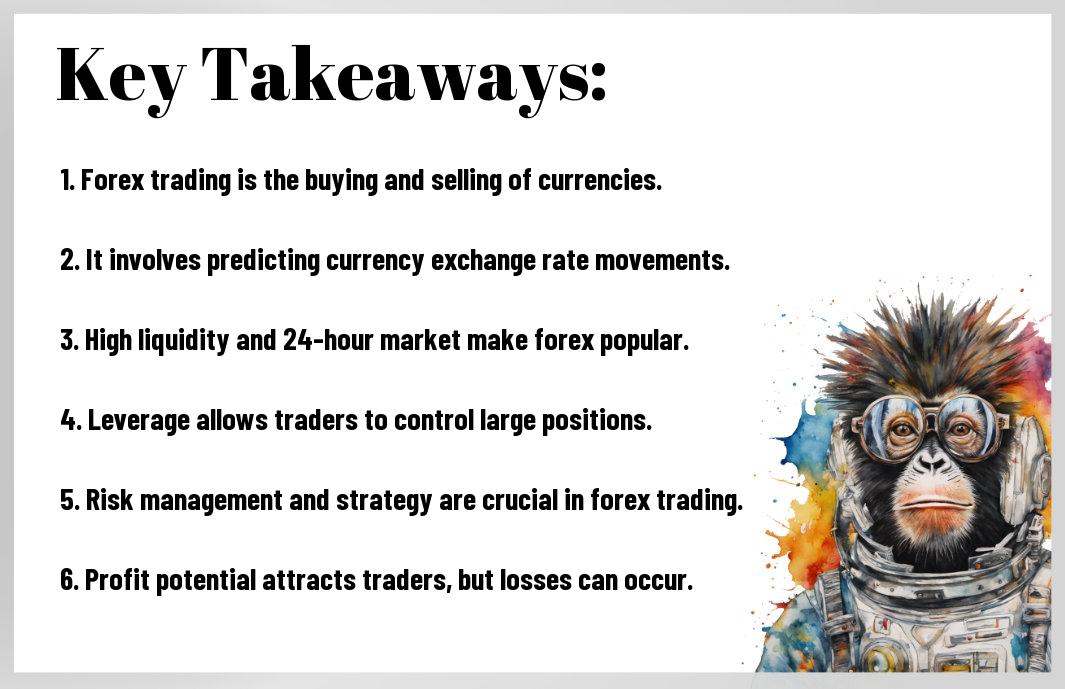It’s a financial market that operates 24 hours a day, 5 days a week, where traders buy and sell currencies in order to make a profit. Forex trading is known for its high volatility, offering opportunities for significant gains but also carrying high risks. Traders speculate on the prices of currency pairs, such as EUR/USD or GBP/JPY, in the hopes of making money based on their market predictions. Understanding the basics of forex trading, including leverage, margin, and risk management, is crucial for anyone looking to participate in this fast-paced and dynamic financial market.
Key Takeaways:
- Forex trading involves buying and selling currencies in the foreign exchange market.
- Currency pairs are traded in the forex market, with the most popular being EUR/USD, USD/JPY, and GBP/USD.
- Leverage is commonly used in forex trading to amplify potential returns, but it also increases the risk of significant losses.

Understanding Currency Pairs
While engaging in forex trading, it is crucial to understand the concept of currency pairs. In the forex market, currencies are always traded in pairs, where one currency is exchanged for another at an agreed-upon rate.
Major Pairs Explained
Major currency pairs are the most traded pairs in the forex market, including EUR/USD, USD/JPY, and GBP/USD. These pairs are highly liquid and involve currencies from the world’s largest economies. Trading major pairs can offer more stability and lower spreads due to high trading volume.
Exotic and Cross Pairs
Understanding exotic and cross pairs is important for diversifying a forex portfolio. Exotic pairs consist of a major currency and a currency from a developing economy, such as USD/TRY or EUR/SEK. These pairs can be more volatile and carry higher risks. Cross pairs do not involve the US dollar and include currencies like EUR/GBP or AUD/JPY.
This provides traders with more options for trading different economies and can offer unique trading opportunities. However, traders should be cautious when trading exotic pairs due to the higher potential for unexpected movements and increased spreads.
The Mechanics of Forex Trading
How Trades are Conducted
Not understanding how trades are conducted in forex trading can lead to significant financial losses. Any trade in the forex market involves the simultaneous buying of one currency and selling another. This is done through a broker or a financial institution, with transactions typically conducted electronically.
Use of Leverage and Margin
Leverage plays a crucial role in forex trading, allowing traders to control large positions with a small amount of capital. With leverage, traders can amplify their profits, but it also magnifies their losses. It is important for traders to understand the risks involved and use leverage cautiously to avoid substantial financial setbacks.
Strategies and Analysis in Forex Trading
Fundamental Analysis
To excel in Forex trading, it is crucial to understand fundamental analysis. Fundamental analysis involves evaluating the economic conditions and policies of various countries to predict the direction of their respective currencies. Key factors considered include interest rates, GDP, inflation, political stability, and trade balances. Traders who master fundamental analysis use these insights to make well-informed trading decisions based on the broader economic picture.
Technical Analysis
To complement fundamental analysis, traders often rely on technical analysis to identify trading opportunities. Technical analysis involves studying historical price charts and using mathematical indicators to forecast future price movements. By analyzing trends, patterns, and signals, traders can pinpoint entry and exit points with precision, enhancing their chances of profitable trades.
Technical analysis provides a detailed view of how prices have moved in the past and offers insights into potential future price movements. Traders use tools such as moving averages, support and resistance levels, and various technical indicators to analyze market sentiment and identify profitable trading opportunities.
Risk Management and Regulation
Managing Trade Risks
Now, when it comes to forex trading, managing trade risks is a crucial aspect of the process. An effective risk management strategy involves setting stop-loss orders, diversifying your portfolio, and only risking a small percentage of your trading capital on each trade. By following these practices, traders can minimize potential losses and protect their investments.
The Role of Regulatory Bodies
On the other hand, the role of regulatory bodies in forex trading cannot be overstated. These organizations, such as the Commodity Futures Trading Commission (CFTC) in the United States and the Financial Conduct Authority (FCA) in the United Kingdom, set and enforce rules to protect traders and ensure fair and transparent markets. They monitor brokers, investigate fraud or malpractice, and provide a layer of security for traders.
Bodies like the CFTC and FCA play a vital role in maintaining the integrity of the forex market. They enforce compliance with regulations, conduct audits, and provide a channel for traders to report any suspicious activities. Regulatory bodies help weed out unethical practices and protect traders from fraud, making the forex market safer for everyone involved.
Summing up
Now, it is clear that forex trading involves the buying and selling of currencies on the foreign exchange market. It is a decentralized financial market where traders can speculate on the price movements of various currency pairs. With its high liquidity and 24/5 trading hours, forex trading offers opportunities for investors to potentially profit from currency fluctuations. However, it also comes with risks due to the volatile nature of the market. To succeed in forex trading, it is necessary to have a solid understanding of the market, develop a trading strategy, and manage risks effectively.
FAQ
Q: What is forex trading?
A: Forex trading, also known as foreign exchange trading, involves the buying and selling of currencies on the foreign exchange market. It is the largest and most liquid market in the world, where currencies are traded 24 hours a day, five days a week. Traders aim to speculate on the price movements of currency pairs to make a profit.
Q: How does forex trading work?
A: Forex trading works by exchanging one currency for another in the hopes that the price will change, allowing the trader to make a profit. Currency pairs are quoted in terms of one currency against another. For example, if you think the euro will strengthen against the US dollar, you would buy the EUR/USD pair. If your prediction is correct and the euro does rise in value, you would sell it back at a higher price, making a profit.
Q: What are the risks involved in forex trading?
A: Forex trading carries inherent risks due to the volatile nature of the foreign exchange market. Some of the risks include market volatility, leverage, geopolitical events, and economic reports that can impact currency prices. It is important for traders to have a solid understanding of risk management techniques, such as setting stop-loss orders and not risking more than they can afford to lose. Proper education, practice, and discipline are key to managing risks in forex trading.
